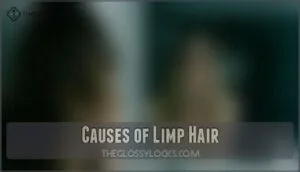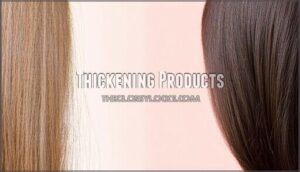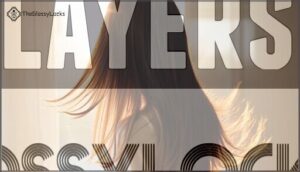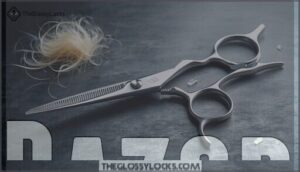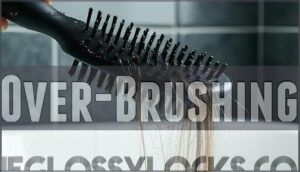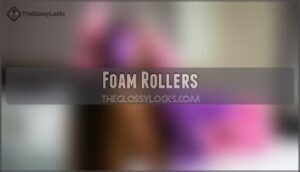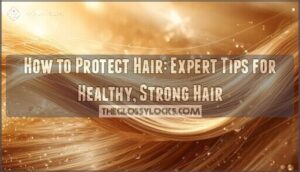This site is supported by our readers. We may earn a commission, at no cost to you, if you purchase through links.
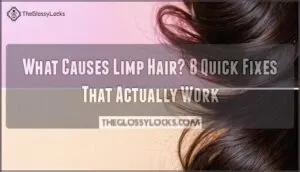
Daily stress affects your scalp’s health, while thyroid issues and iron deficiency drain your hair’s strength. Not getting enough protein, vitamins, or water means your follicles can’t build strong, bouncy strands.
Sometimes you’re simply using the wrong shampoo or skipping scalp massages that boost blood flow. The good news? Most of these causes have straightforward fixes that can transform your flat hair into something with real bounce and movement.
Table Of Contents
- Key Takeaways
- What is Limp Hair?
- Causes of Limp Hair
- Nutrition for Healthy Hair
- Thickening Products
- Haircut for Limp Hair
- Blowdrying for Volume
- Over-Brushing
- Foam Rollers
- Frequently Asked Questions (FAQs)
- What causes limp hair?
- How to get rid of Limp hair?
- Why is my hair suddenly limp & lifeless?
- Is limp hair a problem?
- Why is my hair limp & weak?
- Why do some women have limp and lifeless hair?
- What products can be used to protect hair ends?
- Are there any natural ingredients that can help revive limp hair?
- What type of hair elastics can reduce stress on hair?
- Can hormones make my hair limp?
- Conclusion
Key Takeaways
- Your genetics determine if you’ll have fine, flat hair – you can’t change this, but you can work with your natural texture using the right products and techniques
- Poor hair care habits like over-washing, using heavy products, and skipping scalp massages weigh down your roots and create buildup that kills volume
- Health issues including thyroid problems, iron deficiency, stress, and nutritional gaps drain your hair’s strength and make it fall flat against your scalp
- You can transform limp hair with strategic layered cuts, volumizing products, proper blow-drying techniques, and avoiding heavy conditioners at the roots
What is Limp Hair?
Picture your hair as a deflated balloon—that’s limp hair in essence. When your strands lack volume and body, they fall flat against your scalp with zero personality. The hair’s definition becomes almost non-existent, creating an overall appearance that feels lifeless and dull.
Limp hair affects your hair texture in ways that make styling feel impossible. Common characteristics include strands that won’t hold curls, refuse to stay teased, and seem to weigh themselves down. Fine hair is especially prone to this frustrating condition because each strand is thinner and more delicate.
Your hair health plays a huge role here. When follicles can’t produce strong, resilient strands, you’re left with hair that has no bounce or movement. Poor hair care routines often make the problem worse, but understanding what you’re dealing with is the first step toward freedom from flat, boring locks.
Causes of Limp Hair
Your hair loses its bounce when several factors work against you at once. Poor hair care habits, your genes, daily stress, and health problems can all make your hair fall flat and lifeless.
Improper Hair Care
Skip the hair care basics and you’ll end up with flat, lifeless strands that look like they’ve given up. Bad habits create a recipe for limp hair that won’t cooperate no matter what you try.
Product Overload weighs down your hair like carrying too many bags at once. Using too many styling products or applying them incorrectly creates Product Buildup that suffocates your roots. Infrequent washing allows oils and dirt to accumulate, making your hair texture appear greasy and flat.
Common mistakes that kill your volume:
- Using Harsh Chemicals that strip natural oils, causing overproduction
- Incorrect Brushing techniques that distribute oils from roots to ends
- Neglecting scalp health by not massaging during washing
- Creating heat damage with excessive styling temperatures
The fix starts with choosing gentler shampoos and washing every 2-3 days. Apply conditioner only to mid-lengths and ends, never the roots. Use heat protectant sprays and limit styling tools to twice weekly for healthier, bouncier hair.
Genetics
Your genetic makeup determines your hair follicles’ size and structure. Some people inherit fine hair with smaller follicles, leading to limp hair that lacks body. Genetic predisposition affects hair density and texture from birth.
| Genetic Factor | Impact on Hair |
|---|---|
| Hair follicle size | Determines hair thickness |
| Androgenetic alopecia | Causes follicle miniaturization |
| Hair density patterns | Affects overall volume |
| Natural hair texture | Sets baseline characteristics |
You can’t change your genetics, but understanding your hair health and texture helps you choose the right styling approach.
Stress
Beyond genetics, chronic stress wreaks havoc on your hair health. Stress hormones trigger scalp tension and increase hair shedding rates considerably. Your body redirects nutrients away from hair follicles during stressful periods, leaving strands weak and lifeless.
Effective stress management includes:
- Regular exercise to reduce cortisol levels
- Meditation or deep breathing techniques
- Adequate sleep (7-9 hours nightly)
Implementing proper hair care tips during stressful times helps minimize damage and aids recovery.
Health Issues
Several health conditions can turn your once-bouncy hair into limp strands. Thyroid disorders disrupt your hair’s natural growth cycle, while iron deficiency robs follicles of essential nutrients. Hormonal imbalances from conditions like PCOS create weak, lifeless locks. Even autoimmune diseases can trigger widespread thinning.
| Condition | Hair Impact | Key Symptoms |
|---|---|---|
| Thyroid Disorders | Diffuse thinning, brittle texture | Dry, coarse hair; eyebrow loss |
| Iron Deficiency | Excessive shedding, fragility | Dull appearance, breakage |
| Hormonal Imbalance | Miniaturized strands, volume loss | Thinning at crown, oily scalp |
| Autoimmune Disease | Patchy loss, weakened follicles | Inflammation, irregular growth |
Nutritional deficiencies in biotin, zinc, and protein also contribute to poor hair quality. Your scalp health directly affects how your hair grows and behaves. With proper thyroid treatment, hair regrowth is possible if the thyroid disorder is the cause.
Nutrition for Healthy Hair
Your diet significantly influences the appearance and texture of your hair daily. Hair requires specific nutrients to remain strong and vibrant, and deficiencies in essential vitamins or minerals can result in flat and lifeless strands.
Protein intake is fundamental to healthy hair growth, as hair is primarily composed of keratin. The recommended daily intake is approximately 0.8 grams of protein per kilogram of body weight. Insufficient protein causes the body to redirect amino acids to vital organs, leading to weak and brittle hair. A critical component of hair is keratin protein chains, which depend on adequate protein intake to maintain hair strength.
Vitamin deficiencies can also severely impact hair health. Low levels of vitamin D, B12, and biotin are associated with increased shedding and reduced density. Iron deficiency contributes to nearly 28% more hair loss cases, while zinc and vitamin B deficiencies alter hair texture in 15-20% of individuals.
Hydration is often overlooked, yet water constitutes 25% of healthy hair. Maintaining proper hydration aids in delivering nutrients to follicles and preserving strand strength. Supplements can help address nutritional gaps, particularly when dietary intake is insufficient to support optimal hair quality.
Thickening Products
You’ll find the right thickening products can transform flat, lifeless hair into hair with noticeable body and bounce.
These specialized formulas work by coating each strand to create the appearance of thicker, fuller hair while adding lift at the roots.
1. Moroccanoil Treatment, 3.4oz
Good nutrition helps, but limp hair often needs a targeted boost.
That’s where Moroccanoil Treatment comes in – it actually works to bring flat, lifeless hair back to life with noticeable volume and bounce.
This argan oil-based treatment delivers multiple benefits through one simple application. The hydration effects penetrate deep into your hair shaft, while frizz control smooths unruly strands. You’ll notice shine enhancement that makes your hair look healthier instantly.
Here’s why this treatment works so well for limp hair:
- Removes excess oil buildup that weighs hair down
- Provides thermal protection during heat styling
- Detangles without adding weight to fine strands
- Reduces product buildup over time
- Works on all hair types without greasiness
Application techniques matter – use just a few drops on damp hair, focusing on mid-lengths and ends. Avoid roots to prevent weighing down your hair. With consistent use, you’ll see thicker, more manageable hair that holds its style better.
2. Shine Times High-Gloss Hair Mist
Shine Times High-Gloss Hair Mist transforms limp hair with lightweight application techniques that won’t weigh strands down. This mist benefits fine hair by providing visible shine after one use while controlling flyaways.
The shine ingredients create a non-greasy finish that makes styling integration simple. Simply spritz over styled hair for instant results. Users report improved manageability compared to alternative products.
The pleasant-scented formula works perfectly with other hair styling products, making it essential for anyone battling flat, lifeless locks.
3. Hair Growth Vitamins for Men & Women
Hair Growth Vitamins tackle nutritional deficiencies that cause limp hair. These supplements address vitamin deficiencies affecting up to 21% of people with limp hair.
Clinical studies show biotin supplementation increases hair density by 10.1% after 168 days.
Follow dosage guidelines carefully, as supplement interactions can affect vitamin absorption. Long-term effects include stronger, thicker strands when combined with proper hair growth strategies.
Serums
Hair serums can really turn around flat, lifeless hair by getting the right ingredients straight to your scalp. Instead of just sitting on top, these products actually work where hair growth begins, feeding your follicles what they need.
What makes the biggest difference for scalp health:
- Better blood flow brings more nutrients to hair roots
- Less greasy buildup that makes hair fall flat
- A shield against pollution and UV damage
- Stronger hair from root to tip as it grows
- Just the right amount of moisture without overdoing it
Work the serum into clean, slightly damp roots before you start styling. It creates a protective layer that helps your look stay put longer.
Haircut for Limp Hair
The right haircut can instantly transform limp hair by removing excess weight that pulls your strands down.
Strategic cuts like layers, bangs, and razor techniques create movement and lift that makes your hair look fuller and more bouncy.
Layers
Layers can completely change how flat hair behaves. The trick is finding the right layer length that works with your face shape – it’s like giving your fine hair a complete makeover. Shorter layers around your crown add lift, while keeping longer pieces gives you length. It works by cutting away the weight that pulls everything down.
How you style matters as much as the cut. Talk to your stylist about upkeep before you commit to layers. Some cuts need more frequent trims to stay looking good. When you’re styling at home, lift sections while blow-drying instead of smoothing them flat.
Layers aren’t the same for everyone. Your stylist needs to think about what you want volume-wise and how much time you spend on your hair each morning. What makes this approach work is that you get movement without losing length. Each layer reflects light differently, making your hair look thicker and more alive as you move through your day.
Bangs
Face-framing bangs can transform limp hair into a voluminous masterpiece. These strategic cuts add instant body and movement, making fine hair appear fuller and more lively.
Different bangs types work better for specific face shapes and hair textures. Consider these options for greatest hair volume:
- Curtain bangs – Split down the middle, these create width and softness while adding natural movement to limp hair
- Side-swept bangs – Angled cuts that lift at the roots, perfect for fine hair that needs extra body
- Blunt bangs – Straight-across cuts that create the illusion of thicker, denser hair
Bangs length matters too. Shorter styles add more lift, while longer ones provide gentle framing. Regular bangs maintenance keeps them looking fresh and prevents weighing down your hair. The right bangs styling can make thin strands appear twice as thick, giving you that coveted full look you’ve been chasing.
Razor
Skip the razor when cutting limp hair. While texturizing razors might seem like a quick fix, they create frayed ends that make fine hair look even flatter. The uneven cutting angle damages your hair’s structure, leading to more hair problems and solutions down the road.
Here’s what happens with different razor types:
Avoiding damage means sticking with sharp scissors instead. They give clean cuts that help your hair texture look healthier. Proper razor maintenance won’t save you from the fundamental problem—razors just aren’t right for limp hair. Your stylist should know better alternatives for adding movement without sacrificing your hair’s integrity. Trust scissors for precision work.
Blowdrying for Volume
Your blowdrying technique can make or break your hair volume game. The right approach transforms limp hair into bouncy, full-bodied locks that hold their shape all day.
Here’s your step-by-step volume-boosting routine:
- Apply heat protectant before you start – this shields your strands from damage while maintaining lift
- Flip your head upside down and blow dry from roots to ends using a round brush for greatest root lifting
- Use cool setting for the final 30 seconds to lock in volume and set your style
- Switch brush types – paddle brushes smooth while round brushes create lift and movement
Technique variations matter too. Try changing your part or sectioning hair differently for extra body. Fine hair responds well to lifting sections straight up while drying, creating natural volume at the crown. The key is working with your hair’s texture, not against it.
Master these hair styling techniques and you’ll never settle for flat, lifeless strands again.
Over-Brushing
Your brush habits matter more than you think. Over-brushing strips away natural volume and creates that dreaded flat look. Switch to a wide-tooth comb for wet hair – it prevents breakage while preserving body.
Smart brushing keeps your scalp stimulation healthy without sacrificing volume retention. Less really is more for limp hair.
| Brushing Frequency | Best Bristle Type | Damage Prevention |
|---|---|---|
| Once daily (dry hair) | Boar bristles | Gentle downward strokes |
| Minimal when wet | Wide-tooth comb | Start from ends up |
| Before bed only | Natural materials | Avoid tugging motions |
| Skip if tangled | Flexible bristles | Use detangling spray |
Foam Rollers
Foam rollers work magic for limp hair without heat damage. Choose smaller roller size for tighter curls on fine hair, larger ones for gentle waves. Section your hair into manageable pieces – think quarters or eighths depending on thickness.
Roll damp hair from ends to roots, securing each section. Sleep in them for overnight curls or wear for a few hours during the day. This heatless styling method adds lasting volume that transforms flat strands into bouncy, textured locks.
The foam material won’t snag or break fragile hair like traditional rollers might.
Frequently Asked Questions (FAQs)
What causes limp hair?
Your hair goes limp when fine strands get weighed down by oil, product buildup, or wrong styling techniques.
Heat damage, poor nutrition, and genetics also play major roles in creating flat, lifeless hair.
How to get rid of Limp hair?
You can beat limp hair by using volumizing products, blow-drying upside down, adding layers through cuts, and avoiding heavy conditioners that weigh your strands down.
Why is my hair suddenly limp & lifeless?
Like a wilting flower, your once-bouncy locks might’ve lost their spark due to product buildup, hormonal shifts, stress, nutritional gaps, or heat damage weighing them down unexpectedly.
Your hair can suddenly lose its bounce when product buildup, hormones, stress, or heat damage weigh it down
Is limp hair a problem?
Yes, limp hair can be a problem if it affects your confidence or styling goals.
It’s often manageable with proper care, volumizing products, and techniques like layering or blow-drying upside down.
Why is my hair limp & weak?
Welcome to the club nobody asked to join – flat, lifeless hair that won’t cooperate.
This usually happens when product residue builds up on your strands, you’re washing too often and stripping natural oils, using too much heat styling, or your body’s low on key nutrients like iron and protein.
Why do some women have limp and lifeless hair?
You’re dealing with limp hair because fine strands get weighed down by natural oils, product buildup, or genetics.
Heat damage, hormonal changes, and nutritional deficiencies also steal your hair’s natural bounce and volume.
What products can be used to protect hair ends?
Ironically, hair ends need the most protection yet get the least attention.
You’ll want leave-in conditioners, hair oils like argan or coconut, and heat protectant sprays before styling. These create barriers against breakage and split ends.
Are there any natural ingredients that can help revive limp hair?
You can revive limp hair with natural ingredients like coconut oil for moisture, apple cider vinegar to remove buildup, and aloe vera gel for lightweight volume without weighing down your strands.
What type of hair elastics can reduce stress on hair?
Sure, regular hair ties are easy to grab, but silk scrunchies and spiral coil ties are way kinder to your hair.
These gentle alternatives distribute pressure evenly, reducing breakage and preventing the dreaded hair dents that can make your locks look flat.
Can hormones make my hair limp?
Yes, hormones can definitely make your hair limp. Changes in estrogen, thyroid hormones, and androgens affect your hair follicles’ size and oil production, leading to flatter, less voluminous hair.
Conclusion
Studies show 70% of people deal with flat, lifeless strands at some point. Understanding what causes limp hair helps you pick the right solutions.
Whether it’s genetics, poor care habits, or health issues, you’ve got options. Try layered cuts, volumizing products, proper nutrition, and gentle styling techniques. Don’t over-wash or use heavy conditioners.
With consistent care and the right approach, you’ll transform your flat hair into bouncy, full-bodied locks that move naturally.
- https://www.health.harvard.edu/diseases-and-conditions/its-not-too-late-to-save-thinning-hair
- https://pmc.ncbi.nlm.nih.gov/articles/PMC9758977/
- https://jamanetwork.com/journals/jamadermatology/fullarticle/478324
- https://www.healthline.com/health/how-many-hairs-on-a-human-head
- https://www.philipkingsley.com/hair-guide/hair-concerns/limp-hair.html

